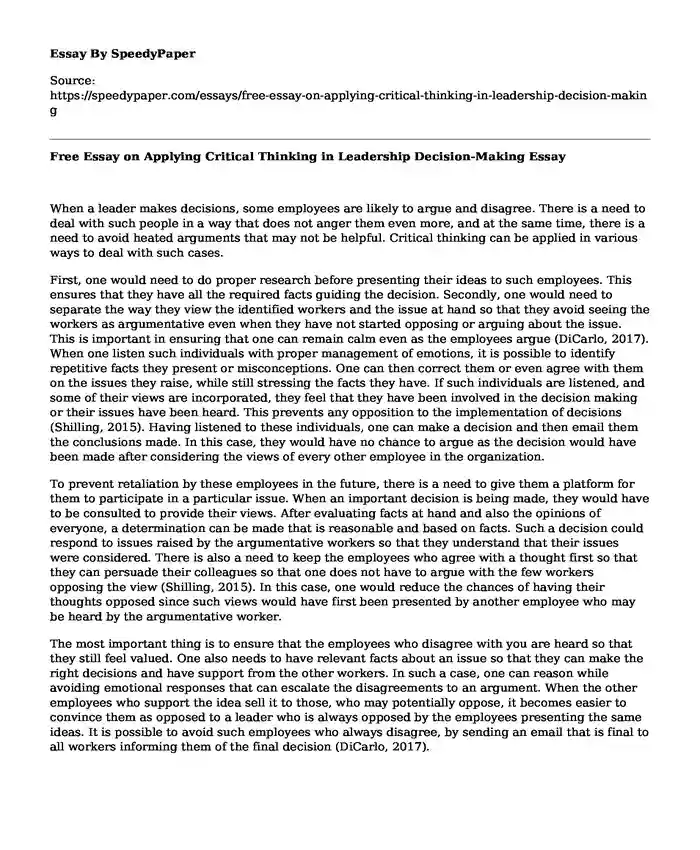
| Type of paper: | Critical thinking |
| Categories: | Leadership analysis |
| Pages: | 3 |
| Wordcount: | 593 words |
When a leader makes decisions, some employees are likely to argue and disagree. There is a need to deal with such people in a way that does not anger them even more, and at the same time, there is a need to avoid heated arguments that may not be helpful. Critical thinking can be applied in various ways to deal with such cases.
First, one would need to do proper research before presenting their ideas to such employees. This ensures that they have all the required facts guiding the decision. Secondly, one would need to separate the way they view the identified workers and the issue at hand so that they avoid seeing the workers as argumentative even when they have not started opposing or arguing about the issue. This is important in ensuring that one can remain calm even as the employees argue (DiCarlo, 2017). When one listen such individuals with proper management of emotions, it is possible to identify repetitive facts they present or misconceptions. One can then correct them or even agree with them on the issues they raise, while still stressing the facts they have. If such individuals are listened, and some of their views are incorporated, they feel that they have been involved in the decision making or their issues have been heard. This prevents any opposition to the implementation of decisions (Shilling, 2015). Having listened to these individuals, one can make a decision and then email them the conclusions made. In this case, they would have no chance to argue as the decision would have been made after considering the views of every other employee in the organization.
To prevent retaliation by these employees in the future, there is a need to give them a platform for them to participate in a particular issue. When an important decision is being made, they would have to be consulted to provide their views. After evaluating facts at hand and also the opinions of everyone, a determination can be made that is reasonable and based on facts. Such a decision could respond to issues raised by the argumentative workers so that they understand that their issues were considered. There is also a need to keep the employees who agree with a thought first so that they can persuade their colleagues so that one does not have to argue with the few workers opposing the view (Shilling, 2015). In this case, one would reduce the chances of having their thoughts opposed since such views would have first been presented by another employee who may be heard by the argumentative worker.
The most important thing is to ensure that the employees who disagree with you are heard so that they still feel valued. One also needs to have relevant facts about an issue so that they can make the right decisions and have support from the other workers. In such a case, one can reason while avoiding emotional responses that can escalate the disagreements to an argument. When the other employees who support the idea sell it to those, who may potentially oppose, it becomes easier to convince them as opposed to a leader who is always opposed by the employees presenting the same ideas. It is possible to avoid such employees who always disagree, by sending an email that is final to all workers informing them of the final decision (DiCarlo, 2017).
References
DiCarlo, C. (2017). Six Steps to Better Thinking: How to disagree and get along. Victoria, Canada: FriesenPress.
Shilling, D. (2015). Complete guide to human resources and the law. New York: Wolters Kluwer.
Cite this page
Free Essay on Applying Critical Thinking in Leadership Decision-Making. (2022, Jun 14). Retrieved from https://speedypaper.net/essays/free-essay-on-applying-critical-thinking-in-leadership-decision-making
Request Removal
If you are the original author of this essay and no longer wish to have it published on the SpeedyPaper website, please click below to request its removal:
- Literary Essay Example: Sigurd the Volsung Research
- Free Essay in Accounting: Basis of Preparation of the General Purpose Financial Reports
- Nursing Essay Sample: The Effects of Post-operative Environments
- Essay Sample on International Social Work, Indian-based
- Paper Example: The Primary Concerns of Waterside Employees
- Free Essay: Health History and Assessing the Determinants of Health
- Free Essay - Final Care Coordination Plan
Popular categories




